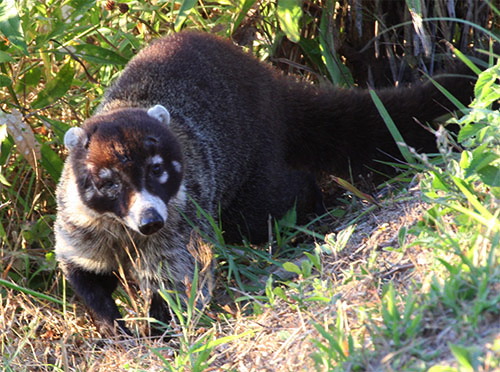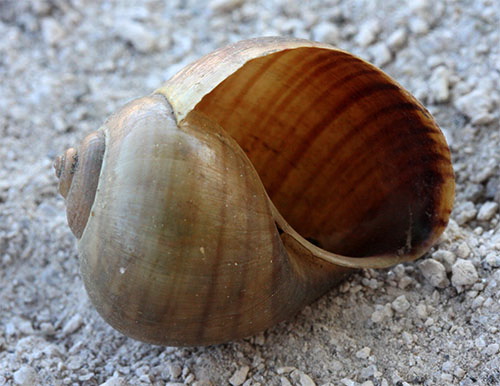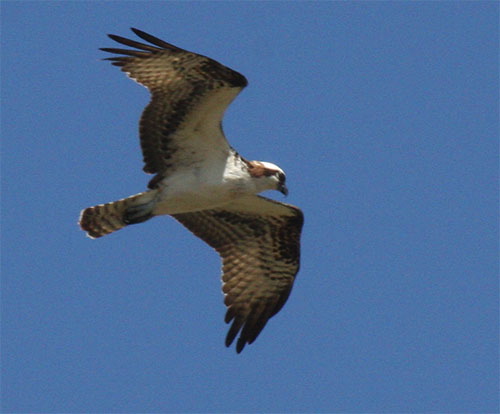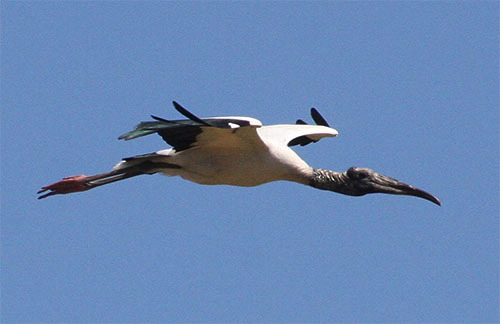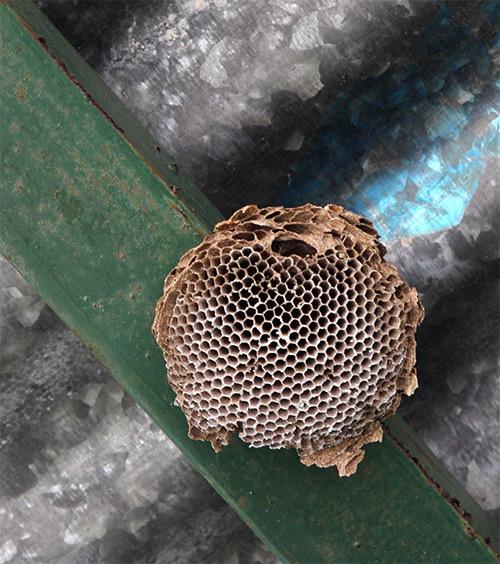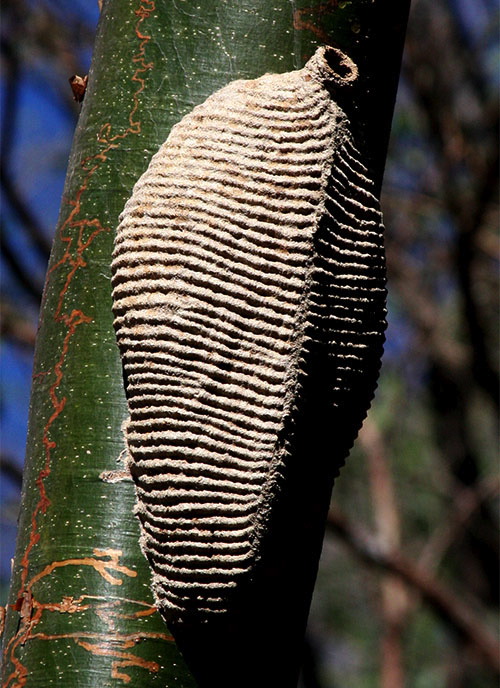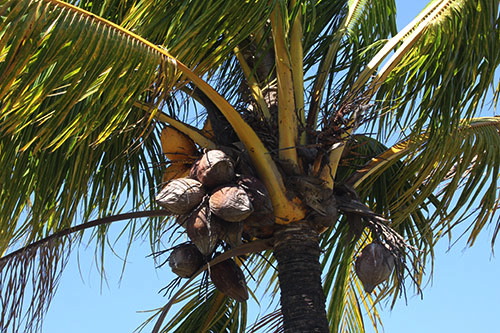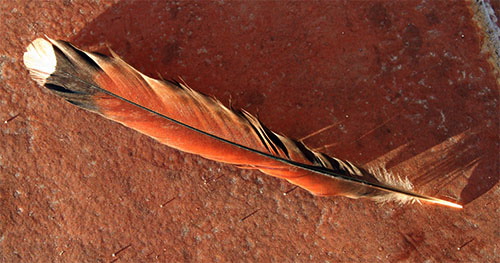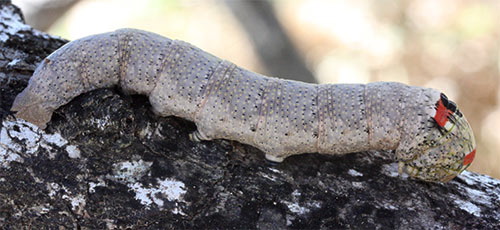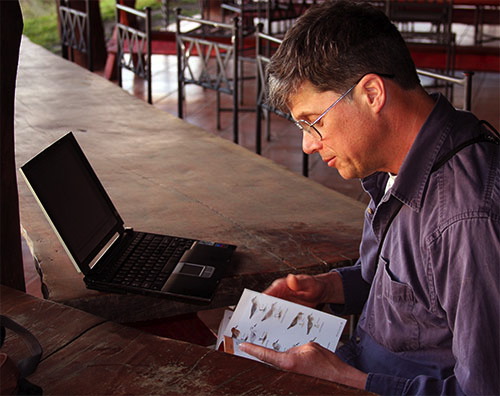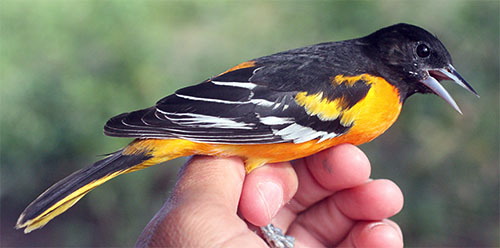|
|
|||
|
(Back to Preceding Week; on to Next Week) |
|
NOTE 1: We spent more than four weeks banding hummingbirds in Costa Rica in early 2009. The following account is for Week Two. Accounts are now posted for Week One and Week Three; a Summary Report for 2009 is also available. We recommend you read the accounts in chronological order to better understand the whole sequence of events. Every week was different, so we hope you enjoy all the summaries. NOTE 2: A least four more nine-day Operation RubyThroat hummingbird expeditions are scheduled for January-March 2010 to Central America (Costa Rica and--for the first time--Guatemala and Belize). For more information see 2010 Tropical Hummingbird Banding Expeditions and contact EDUCATION.) HUMMINGBIRDS IN COSTA RICA: Week One of our annual Operation RubyThroat hummingbird expeditions to Costa Rica ended on 1 February as trip leader Bill Hilton Jr. and expert guide and colleague Ernesto Carman Jr. bid farewell to 14 Alpha Niner participants at the Liberia airport in Guanacaste Province. Week Two wasn't due to start until 3 February with the arrival of the Beta Niners, so we (Hilton and Carman) followed our tradition of returning from the airport to downtown Liberia for a celebratory round of ice-cold guanabana (AKA Soursop, or Prickly Custard Apple)--
All text, charts, maps & photos © Hilton Pond Center After discovering this vast expanse (above) of nectar-bearing aloe blooms, we (the two Omega Niners) spent the afternoon on Groundhog Day (2 February) running four mist nets outside the northwestern perimeter of the Carrington property (dubbed "CP1")--where we captured 20 Ruby-throated Hummingbirds! This four-hour effort netted exactly the same number of RTHU the Alpha Niners caught during six days of field work under conditions that could have been much better--what with a machete-induced loss of edge plants and relative scarcity of aloe flowers in the group's Cañas Dulces fields. (If it ain't one thing, it's the other.) We could hardly wait for the Beta Niners to arrive so we could introduce them to our new-found Carrington study site. DAY ONE (3 Feb), BETA NINERS: The two Omega Niners slept in a little on 3 February, knowing we had to pace ourselves in anticipation of the week of field work ahead. Whiskers returned during the night with his regular bus--windshield graced with images of his favorite musician, Bob Marley--and that morning after breakfast we hopped aboard for a ride to the Liberia airport and our hoped-for rendezvous with the eight Beta Niners. This was the smallest group we'd ever worked with through Operation RubyThroat--two couples had to drop out at the last minute due to serious health issues--but based on their impressive biographical info we were confident the Week Two participants could get the job done in Costa Rica.
All text, charts, maps & photos © Hilton Pond Center We greeted the first four folks at the Liberia airport: Deb Soule (Rockport ME), Greg McCrone (Dover NH), and Pat & Pete Petersen (Hendersonville NC). We also picked up Jerry & Terry Williams Portola CA) who had come in early and were waiting at a local hotel, but Lynette Fullerton (Lanham MD) and Dave Mozurkewich (Seabrook MD) were nowhere to be found. (We eventually heard from a Holbrook Travel representative they had missed a flight en route and would join us later.) With luggage properly stowed, the traveling party re-boarded the bus and headed up the mountain for Buena Vista Lodge, arriving in time to unpack and make it to our now-traditional sunset watch (above) at El Mirador. Later, just as we got to supper, a taxi rolled into the lodge's reception area. The good news was that Lynette and Dave were inside; the bad news was that the driver wanted $97 for bringing the duo and their luggage from the Liberia airport to Buena Vista. Ah, international travel . . . . Now that our Beta Niner group was complete we celebrated with our usual first-night introductory presentation, made somewhat difficult by moderate winds that had begun to whistle through nearby trees. Little did we know. DAY TWO (4 Feb), BETA NINERS: The wind blew "a little more" during the night--enough to make the Beta Niners understand why we had suggested they bring ear plus for just such an event. We estimated those overnight gusts were "only" about 20-30 mph or so. After an early wake-up call, everyone had a hot breakfast and climbed into Whiskers' bus for the first Week Two trip down the mountain. (Since the wind was behind us we're guessing Whiskers got better mileage than usual.) As we had done with the Alpha Niners, we helped the Beta Niners re-live what had happened back in Year One with the Pioneers: 1) We walked to Aloe Vera Field #1 (AV1) where we were disappointed by the near absence of aloe blossoms; 2) we paid homage to the now-chopped Jocote tree where Year One participants had been able to trap a few ruby-throats; and, 3) we visited the other Cañas Dulces aloe fields and were equally chagrined to see a scarcity of flower stalks. Needless to say, after finding our historical sites less than optimal, the Beta Niners were more than elated when we drove further south past Liberia to the Carrington plantation, where they were greeted by what we believe may be the largest expanse of aloe flowers in Central America.
All text, charts, maps & photos © Hilton Pond Center As described in last week's report, the Carrington processing plant was closed and we weren't able to actually enter their vast aloe field, but we did have access to public property adjoining it. Along the northwest perimeter of the Carrington plantation was a ten-foot-tall berm (see photo above), atop which a barbed wire fence kept trespassers (and us) at bay. Outside the berm was a deep ditch, and outside that was another even taller berm with a footpath along its length. It was on the outside berm the Beta Niners were able to erect mist nets--an ideal location because hummingbirds flying from the aloe fields passed over the barbed wire and right into the nets. Wahoo!
All text, charts, maps & photos © Hilton Pond Center Although the wind blows some days up at Buena Vista Lodge on the volcanic slope, the fields at Cañas Dulces are seldom windy. However, because of the way mountain passes are situated, when there IS wind it's usually windier at Liberia where Carrington is located. Thus, the Beta Niners experienced gusty conditions--which we anticipated when we asked them to guy down the net poles with ropes and stakes. This turned out to be very good advice, for between set-up time at 9:30 a.m. and shut-down at 11:15 a.m. the winds increased so much the metal net poles would have been bent by the breeze. Nonetheless, on their first day in the field at Carrington the Beta Niners captured eight Ruby-throated Hummingbirds--including six adult females, an adult male, and the first partially gorgetted second-year male (above) banded at that location.
After a good day in the field at Carrington the Beta Niners traveled back up the volcano to Buena Vista, where the winds continued to increase in intensity all afternoon. That evening at 8:50 p.m. near the end of our slide presentation about hummingbird behavior the power flickered, went out, and stayed out--undoubtedly because some tree toppled by the wind had fallen across transmission lines. All night there were near-constant strong winds in the 35-45 mph range. Thank heavens for earplugs.
DAY THREE (5 Feb), BETA NINERS On 5 February the group rose early as usual and went to breakfast. There was still no power, so the enterprising dining hall staff had to prepare the pre-dawn hot meal on gas stoves by candlelight, with which the Beta Niners were most impressed. Although we decided to take the bus down the mountain as usual for a morning of field work, progress was impeded significantly by fallen trees and vines along the way. At several spots Ernesto jumped from the vehicle with his trusty machete and chopped smaller branches (above), but we wouldn't have made any progress at all had some local residents not come out with chain saws to remove larger trees completely blocking the road. Billboards, commercial signs, and electric and phone lines were down--even concrete power poles were snapped--and when we got to Liberia we found the town (population 40,000) completely without power except for computers using battery backups and grocery store coolers hooked to gas generators. The local residents said it was the worst windstorm damage they'd seen in a very long time.
Even down in the flatlands around Liberia the winds were still blowing too hard for us to run nets at Carrington's aloe plantation, so our field work that day had to be cancelled. Instead we went over to visit El Sitio Best Western Hotel where Jerry and Terry Williams had stayed when they arrived in Guanacaste earlier in the week. Awaiting pickup the Williams couple had discovered a hummingbird nest in a tree high above the hotel's inner courtyard; we begged permission from management to take the group in to see if it could be located again. Eagle-eyed Ernesto was first to spot the nest, about 60 feet up on the tip of a branch swaying ominously in the wind. The nest was moving back and forth so much it was scribing a six-foot arc and we wondered how in the world the nearly full-grown chick was able to stay aboard. Perhaps 15 feet away on a different branch the nestling's sibling--a premature fledgling--was also holding on for dear life. After several dizzying views through a spotting scope we finally were able to see faint streaks of chestnut down the sides of the chicks' necks, diagnostic evidence they were Green-breasted Mangos--one of the more common bigger hummingbirds in Guanacaste. Eventually an adult hummer flew in and perched on an equally precarious windblown branch; this bird was all dark with a slightly decurved bill (above)--very likely the male parent of the two young mangos.
All text, charts, maps & photos © Hilton Pond Center In addition to the hummer nest the hotel also had a small wetland adjoining its courtyard; there we got to see Northern Jaçanas and a few other waders. The stiff breeze made it really difficult to bird, so we went back to Buena Vista Lodge for lunch, some rainbow observations, a few wind experiments (including Ernesto's unsuccessful attempts to fly using a bath towel, above), an afternoon discussion about hummingbird reproduction, and a candlelight supper. Since the power was still off after 24 hours everyone turned in early at about 8 p.m. to try sleeping in spite of the wind. The earplugs really came in handy in that the breeze was now nearly constant at 45-55 mph, with occasional gusts of at least 65--all night long!
All text, charts, maps & photos © Hilton Pond Center DAY FOUR (6 Feb), BETA NINERS: With such zephyrs blowing through we decided on a late wake-up call for the morning and arose on 6 February to continuing winds. (It was hard to describe what these windy days were like, even harder to photograph them; see windblown people and palms above.) The wind had gotten so bad Buena Vista Lodge was essentially shut down--no horseback rides, no day trips to the volcanic spa, no canopy tours, no phone or electricity, no nothing except for still-delicious meals cooked on gas stoves. Despite all this the Beta Niners remained positive and upbeat and admitted there was no sense fretting about weather anomalies over which we had no control. On this day we knew it wouldn't be possible to run mist nets at any of the aloe fields, so we opted to ride to lower elevations just to see if birding might be possible.
On the bus ride down we were met by even more damaged vegetation and many house roofs blown off. Trees were down in the churchyard at the town of Buena Vista and we were heartbroken to see the covered basketball/soccer arena (above) at the school in Cañas Dulces had collapsed. We're hopeful it somehow can be rebuilt before the rainy seasons starts so neighborhood young people will have a place out of the elements to shoot hoops and practice soccer.
All text, charts, maps & photos © Hilton Pond Center Because the town of Liberia was still quite windy we drove west past the airport to an inactive freshwater shrimp farm along the main highway. That far from the volcanic ridge we finally were able to escape stiff breezes and get in some spectacular birding among numerous shallow water-filled trenches perhaps 20 yards wide and 200 yards long.
All text, charts, maps & photos © Hilton Pond Center By late morning it wasn't just that we didn't want to quit birding the shrimp farm; no, we almost dreaded going back up the hill to Buena Vista Lodge--knowing full well the wind probably was still blowing. Our predictions proved correct; we were greeted by 50 mph gusts that were continuing to tear down gutters, bend metal roofs, and shred vegetation.
All text, charts, maps & photos © Hilton Pond Center Some Beta Niners (above) braved the breeze that evening to watch a fine sunset, but having to brace one's body, ears, and psyche against constant and nearly gale-force wind was beginning to wear on the group. Who could have guessed Buena Vista's half-acre retaining pond (below) would be covered with wind-whipped whitecaps? After another candlelight supper and similarly lit evening hummingbird discussion, we again retired early. There had been no power for 48 hours, which meant--among other things--no one had been able to take a relaxing hot shower for at least that long.
DAY FIVE (7 Feb), BETA NINERS: Sometime during the wee hours on 7 February power was restored for Buena Vista Lodge. This unexpected phenomenon woke up and startled several group members who had forgotten to turn off their overhead light switches. None of them complained, however, at least not until the power went back off again. Eventually everything got fixed, the group had a later-than-usual breakfast, and in good spirits we decided to go down toward Liberia in the hope winds had diminished enough to allow mist netting. When we got to the Carrington plantation conditions were not perfect--gusts were still coming at about 20-25 mph--but having missed two consecutive field days we simply had to try catching some hummers. With proficiency and conscientious effort the Beta Niners speedily erected ten nets and anchored them out so well that in just two-and-a-half hours we banded 14 Ruby-throated Hummingbirds around the perimeter of Carrington's aloe fields. We should point out that all Ruby-throated Hummingbirds we captured at Carrington got a uniquely numbered aluminum leg band, but we also marked each bird with two horizontal lines of temporary blue dye. This allowed us to know whether banded birds remained on the study site after banding, which they often did. Birds banded at Cañas Dulces got a single horizontal line of dye (above left) so we could differentiate those birds from the ones caught at Carrington. Although the dye usually wears off after a few weeks in the tropical sun, there is slight possibility one of our color-marked ruby-throats could be seen at a feeder in the U.S. early this spring.
By 10:30 a.m. the wind had increased so significantly we deemed it wise to take down our nets lest the task become next to impossible. Besides, it was a good day to go into Liberia for our usual meal at the Chinese restaurant (above), where for the first time in history no one in our group ordered Red Snapper.
All text, charts, maps & photos © Hilton Pond Center On the way back up to Buena Vista we made an unplanned stop at "The Wall," a towering vertical rock face cut by a small river. High above the stream was a small cavern we always glanced at when the bus drove by--mostly because we had seen Mantled Howler Monkeys around it in past years. On this day, however, a bird perched within, one with a black hood and rust-colored pantaloons--unquestionably a Bat Falcon, Falco rufigularis. This formally attired bird is about the size of an American Kestrel and hangs out on cliffs from which it makes a living preying on speedy birds such as swifts, swallows, and hummingbirds, and--as its name suggests--bats that are crepuscular (flying at dawn and dusk). We hope the Bat Falcon hasn't developed a taste for ruby-throats.
A little further up the mountain we stopped at a big Kapok tree, Ceiba pentandra, in flower and were delighted to find Ruby-throated Hummingbirds taking nectar. Their main competitors for the sweet juice appeared to be non-migratory Streak-backed Orioles, Icterus pustulatus--including a brightly colored adult male (above) that was totally engrossed in feeding on Kapok flowers. This tropical oriole occasionally shows up in Arizona, California, and the southern U.S. and has even been recorded in Colorado.
All text, charts, maps & photos © Hilton Pond Center DAY SIX (8 Feb), BETA NINERS: Winds diminished considerably at Buena Vista Lodge during the preceding evening, so on the morning of 8 February we headed out again for the aloe fields at Carrington at our "normal" hour. The Beta Niners had the nets in place and staked down by 7:10 a.m. and we caught our first Ruby-throated Hummingbird two minutes later. It was a bit breezier than we might like, but the hummers hit the nets with regularity during the morning, eventually giving us an excellent total of 16 ruby-throats: A second-year male, three adult males, and 12 adult females. Other migratory Neotropical species we banded on 8 February were Orchard Oriole (2), Painted Bunting, Tennessee Warbler (5), Yellow Warbler, and Rose-breasted Grosbeak.
All text, charts, maps & photos © Hilton Pond Center Because mist nets are non-selective, we often capture other birds besides hummers that are the main focus of our work in Costa Rica. Such was the case on the morning of 8 February when a Turquoise-browed Motmot got snared temporarily (see two photos above). Ernesto carefully removed this Blue Jay-sized bird from the net and brought it to the banding table, where the Beta Niners shot numerous photos as they oohed and ahhed over the motmot's colorful and unusual plumage characteristics. In addition to bright iridescence, the motmot displayed an interesting attribute--two long central tail feathers that were pendulum-shaped (above and below).
All text, charts, maps & photos © Hilton Pond Center Costa Rica has six motmot species, all but one of which have racquet-shaped tails they swing back and forth while perched. When the central rectrices first come in they have the same general shape as other birds' tail feathers, even though the barbs along part of the tail are not well-formed. Motmots--in their own family (Momotidae)--are related to kingfishers (Alcedinidae). Members of both families nest in tunnels, have serrated bills (refer to motmot mug shot above), and exhibit syndactyly (two outer front toes fused at the base; see motmot foot above left). Motmots are quite predatory, taking almost anything they can swallow--from lizards and snakes to frogs and large insects. The colorful 13-inch-long Turquoise-browed Motmot, Eumomota superciliosa, is the national bird of both El Salvador and Nicaragua; Costa Rica's is the rather plain-looking Clay-colored Robin (or Thrush), chosen in part because its song is said to summon rain needed for agricultural success.
All text, charts, maps & photos © Hilton Pond Center The evening of 8 February was enjoyable because of our usual technicolor sunset and--not too long thereafter--a much-more-subtle-but-just-as-impressive full moon (above) peeking through the cloud bank hanging above the top of Rincon de la Vieja volcano.
All text, charts, maps & photos © Hilton Pond Center DAY SEVEN (9 Feb), BETA NINERS: For each day of field work, we depart Buena Vista Lodge just before the sun comes up and bus down the mountain toward our study site. When we get to a small volcanic cone we call Sugarloaf we know we're on time if the top of the peak is beginning to be bathed in sunlight. Soft morning rays light up Sugarloaf in a very special way that always seems to buoy everyone's spirits. We got a special treat early on 9 February when that full moon from the evening before was setting just as we got to Sugarloaf (above)--more evidence there are some great views in the world for folks who take time to look. The Beta Niners' fourth field day at the Carrington perimeter site (CP1) was almost a carbon copy of the day preceding: Moderate winds requiring that we stake down the nets, four hours of netting and observation, and--once again--16 Ruby-throated Hummingbirds captured and banded. This time there were three second-year males, two fully gorgeted adult males, and 11 adult females.
That day we also caught several other birds besides hummers, including Northern Oriole, Great Kiskadee (above), and Mangrove Cuckoo (below). We banded the oriole--it's a Neotropical migrant that returns to North America come spring--but our permit doesn't allow us to use U.S. bands on non-migratory Costa Rican resident birds like the other two species. Great Kiskadees, Pitangus sulphuratus, are so big and colorful it's almost hard to believe they're actually flycatchers related to drab little birds such as phoebes and wood-pewees. The heavy, slightly hooked bill of this species allows them to capture almost anything they want, including big insects, small rodents and reptiles; the kiskadee is even one of the few songbirds known to dive for fish. A pair typically builds in a conspicuous place--this year we found a big, messy kiskadee nest on a utility pole at Cañas Dulces--and parents fearlessly defend their young against hawks and other predators.
Mangrove Cuckoos, Coccyzus minor, are indeed Costa Rican residents, but a Florida population of this species is known to migrate south; thus, there's a slim possibility the cuckoo we caught at Carrington came from North America. Despite their name, Mangrove Cuckoos in Costa Rica are more likely to nest in gardens and shrubland than in mangrove swamps. Note the yellow eye ring on this bird; it's formed not by feathers but by bare skin.
We've found through the years that midday isn't a great time to mist net hummers in Costa Rica, so we typically shut down by 11:30 a.m. on field days. (Besides, that gives each group time to return to Buena Vista Lodge in time for lunch.) On 9 February we dismantled the nets at our typical time but instead of taking the bus back up the mountain headed for Santa Rosa National Park and our planned field trip into the Guanacaste dry forest. Our day trips to Santa Rosa are always interesting and even though we've been there many times we always come across something new. This week it happened to be a huge beehive high up against the ceiling of an observation tower (above). Although the hive appeared not to be active, it was almost surely the work of Honeybees, Apis mellifera, and--based on our experience elsewhere in Costa Rica--were probably of the Africanized variety. These aren't really "killer bees" but can be aggressive, as the Omega Niners (Hilton and Carman) learned somewhat painfully when they got too close to a hive tree at Carrington plantation.
All text, charts, maps & photos © Hilton Pond Center After looking around at Santa Rosa the group headed for Junquillal Beach and a hoped-for swim in the Pacific Ocean. The previous week the waters were made dangerous by a massive invasion of two-inch jellyfish, but on 9 February the stinging coelenterates were many fewer in number--allowing the Beta Niners to at least get their feet wet in the surf.
All text, charts, maps & photos © Hilton Pond Center DAY EIGHT (10 Feb), BETA NINERS: The Beta Niners were scheduled for six days of field work in 2009, but heavy winds earlier in the week interfered; as a result, their fifth day at Carrington was also their last. Four hours of mist netting on the final day at Carrington yielded 12 ruby-throats: two partially gorgeted second-year males and ten adult females. A young male was one of the more oddly plumaged birds we've captured in Guanacaste Province. His forehead (above) was as drab and brown as any we've seen on a Ruby-throated Hummingbird, while a frontal view (below) showed unusually fluffy juvenile throat feathers with brown centers, a few feathers in quill, and about a dozen iridescent red adult feathers. Even though it was almost mid-February, this bird had a ways to go before he acquired full breeding plumage he would need as an adult male on the nesting grounds back north.
With their 12 birds on Day Five the Beta Niners' total came to a very impressive 66 RTHU captured and banded at the Carrington aloe plantation--second only to the 77 hummers caught by the Crazy '08s Omega group last year during six days in the field. (See 2009 tables in the summary section below.) Other migratory Neotropical species we banded on 10 February were Yellow Warbler (2) and Baltimore Oriole (2). (Click on image above to open a larger photo in a new browser window) DAY NINE (11 Feb), BETA NINERS: As might be anticipated, the sun came up on 11 February unaccompanied by no wind whatsoever--just the conditions that would have been most helpful when the Beta Niners were trying to catch hummingbirds earlier in the week. Instead this was fly-out day for Week Two participants, all of whom did an exceptional job under very trying weather conditions and resulting lack of electrical power. The Beta Niners agreed to give up their "Hump Day" at midweek in return for the great morning we spent watching birds at the shrimp farm. That particular field trip helped considerably in enabling the group to see 121 species of Costa Rican birds--as list by trip compiler Greg McCrone--marking a new one-week record high for eight Operation RubyThroat groups to date. We're especially grateful for the group's positive attitude, dedication, and hard work, and we look forward to the possibility of the Beta Niners returning to Guanacaste Province some year when the wind couldn't possibly blow as hard as it did during their tenure in February 2009. One good thing about the windy weather was it made the Omega Group (Hilton & Carman) even more appreciative of the GREAT weather we've had on all the other Operation RubyThroat expeditions during the past five years. NOTE: Please scroll down for a summary of results from Week Two, a running total of Ruby-throated Hummingbirds banded in 2009, and a scrapbook of Beta Niner photos. There's also a postscript explaining what caused several days of unprecedented high winds that plagued Week Two. All text, maps, charts & photos © Hilton Pond Center BETA NINERS GROUP (Week Two) RESULTS As shown in Table 1 (below), during Week Two female RTHU again outnumbered males by more than two-to-one.
As shown in Table 2 (below) when banding totals from the Alpha Niners and Beta Niners are combined with the one-day, 20-bird production by the Omega Niners, the ratio remains heavily on the side of females.
All text, maps, charts & photos © Hilton Pond Center BETA NINERS SCRAPBOOK We hope you'll enjoy the following images of people, places, plants, and wildlife, taken during Week Two of our 2009 hummingbird banding expeditions to Costa Rica.
All text, maps, charts & photos © Hilton Pond Center We've been trying for five years to get a decent photo of a White-nosed Coati, Nasua narica, but this long-tailed relative of the Raccoon never shows up when we have camera in hand. This year we finally spotted one near dusk at the sunset lookout (above); its right eye was apparently blinded by a heavy wound that may have a come from territorial battle with another coati.
All text, maps, charts & photos © Hilton Pond Center In freshwater shrimp farm ponds west of Liberia, common invertebrates include at least one species of Apple Snail (above). These mollusks are the favored food of the Limpkin--a large wading bird related to cranes and rails.
All text, maps, charts & photos © Hilton Pond Center An Osprey, Pandion haliaetus, soaring overhead at the shrimp farm near Liberia was unmistakable, with its bright white forehead and W-shaped wing profile.
All text, maps, charts & photos © Hilton Pond Center Also on the wing and foraging at the shrimp farm were several Wood Storks, Mycteria americana (above), distinguishable from the larger Jabiru by the former's black primary feathers and the lack of a red gular (throat) sac.
All text, maps, charts & photos © Hilton Pond Center Social insects are prevalent in the tropics, from Leaf-cutter Ants to many species of bees, wasps, and hornets. We found a paper wasp nest (above) hanging from a rafter near the corral in which Buena Vista Lodge keeps its horses.
All text, maps, charts & photos © Hilton Pond Center Along the road halfway down the mountain from the lodge was another communal insect nest, likely from a species of Polistes wasp. This structure, made from chewed wood formed into paper, was very pleasing to the eye. If a human entered a creation like this in an art competition it would probably win first prize.
All text, maps, charts & photos © Hilton Pond Center Palm trees are everywhere in Costa Rica; in fact, we were surprised on our first visit to find them growing deep into rain forest areas. Fruit of the Coconut Palm, Cocos nucifera (above), is available for one dollar U.S. from street vendors across the country, giving passers-by a cool, healthy way to quench thirst. (WARNING: If the wind is blowing, don't stand under a Coconut Palm without a hard hat.)
All text, maps, charts & photos © Hilton Pond Center This foot-long, white-tipped, chestnut-colored feather unquestionably came from the tail of a Squirrel Cuckoo, Piaya cayana, named for its habit of hopping through shrubs and trees like a squirrel.
All text, maps, charts & photos © Hilton Pond Center This unidentified five-inch-long caterpillar--possibly from a species of Sphinx Moth--would have made a nice, succulent meal for that Squirrel Cuckoo that had lost its tail feather.
All text, maps, charts & photos © Hilton Pond Center For a hardcore birder, no locale is too remote for updating one's checklist. Here Dave Mozurkewich of Seabrook MD goes over the day's sightings and logs them into his laptop computer while watching the sunset from El Mirador.
All text, maps, charts & photos © Hilton Pond Center This formally attired male White-lored Gnatcatcher, Polioptila albiloris, was captured incidentally in our hummingbird nets at the Carrington aloe field. In non-breeding seasons the male loses some of his black facial markings and the lore--the area between the eye and base of the bill--becomes white, hence the species' common name.
|

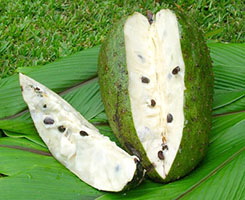 a refreshing non-alcoholic drink from the white pulp of a spiny green fruit (right) related to the Pawpaw that grows at Hilton Pond Center. Our intrepid bus driver Guillermo "Whiskers" Hernandez didn't join us this time because he had to take his bus back to San Jose for scheduled maintenance before returning for Week Two. Fortunately Ernesto again had his four-wheel-drive car available, so in light of our somewhat disappointing first week of banding Ruby-throated Hummingbirds in the Aloe Vera fields around Cañas Dulces (see the
a refreshing non-alcoholic drink from the white pulp of a spiny green fruit (right) related to the Pawpaw that grows at Hilton Pond Center. Our intrepid bus driver Guillermo "Whiskers" Hernandez didn't join us this time because he had to take his bus back to San Jose for scheduled maintenance before returning for Week Two. Fortunately Ernesto again had his four-wheel-drive car available, so in light of our somewhat disappointing first week of banding Ruby-throated Hummingbirds in the Aloe Vera fields around Cañas Dulces (see the 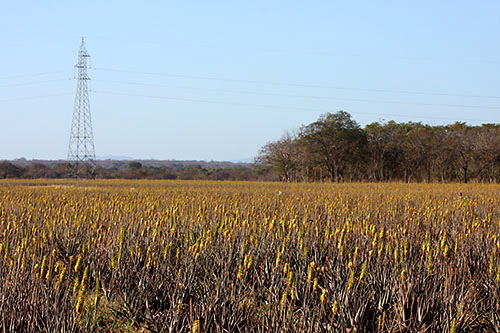
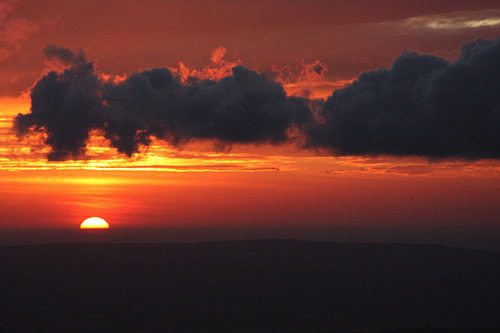
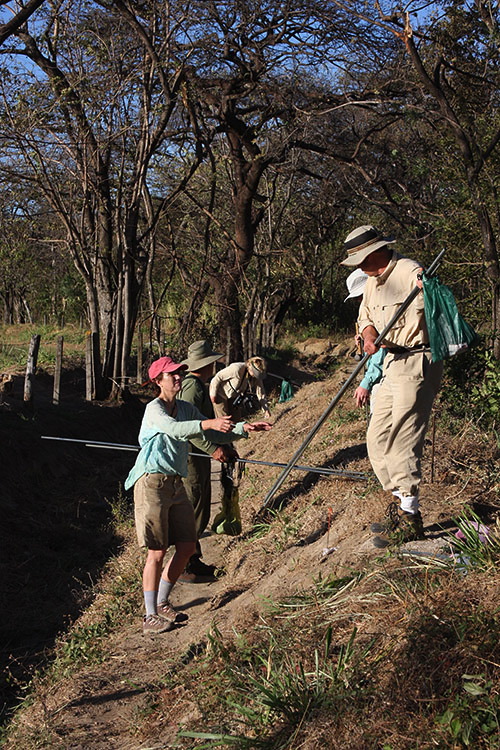
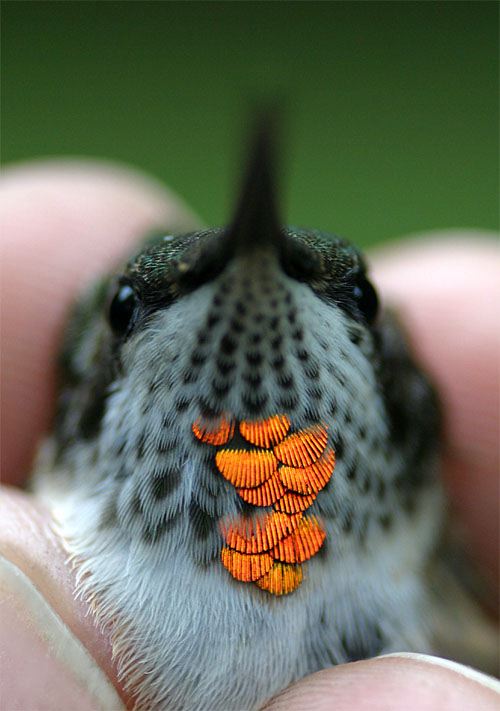
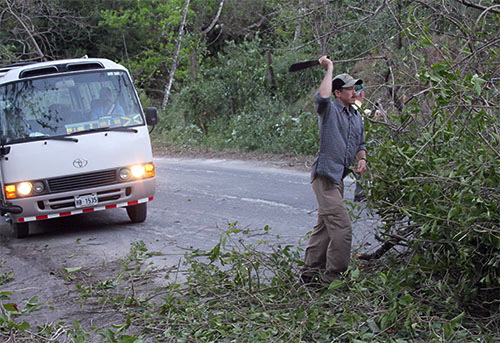
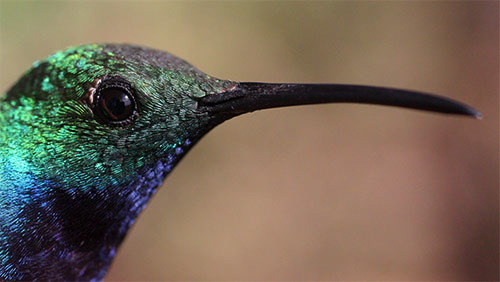
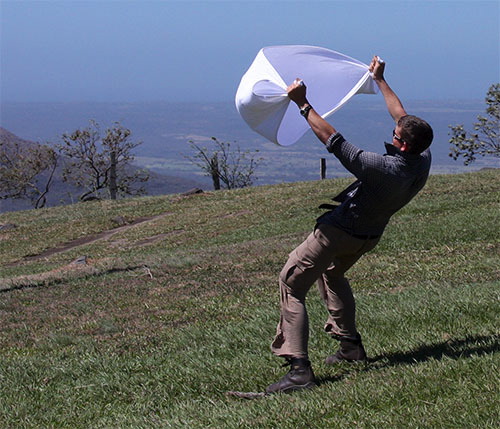

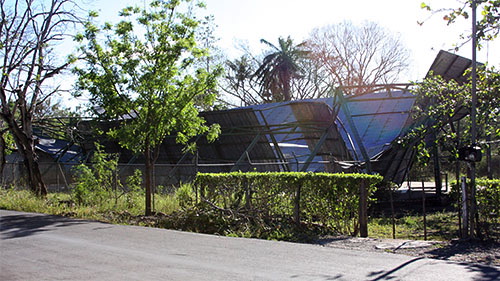
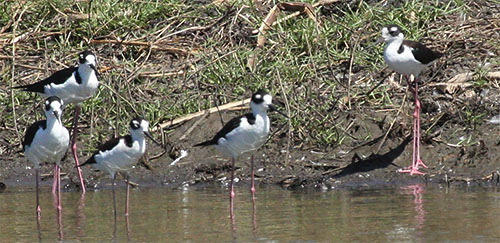
 Standing water is extremely hard to find in Guanacaste Province during the dry season so these partially drained shrimp pools were real magnets for aquatic species. There were Osprey, Black-necked Stilts (above), Northern Jaçanas, Wood Storks, Black and Turkey Vultures, various egrets and herons and ducks and shorebirds, and in the distance a Jabiru, Jabiru mycteria (above right)--a big, heavy-billed four-foot-tall stork that was a life bird for everyone except Ernesto. A lone Limpkin, Aramus guarauna (below), stalked pond edges in pursuit of its favored food--escargot--in the guise of Apple Snails.
Standing water is extremely hard to find in Guanacaste Province during the dry season so these partially drained shrimp pools were real magnets for aquatic species. There were Osprey, Black-necked Stilts (above), Northern Jaçanas, Wood Storks, Black and Turkey Vultures, various egrets and herons and ducks and shorebirds, and in the distance a Jabiru, Jabiru mycteria (above right)--a big, heavy-billed four-foot-tall stork that was a life bird for everyone except Ernesto. A lone Limpkin, Aramus guarauna (below), stalked pond edges in pursuit of its favored food--escargot--in the guise of Apple Snails.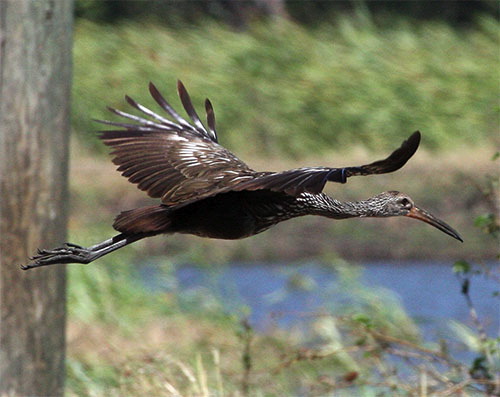
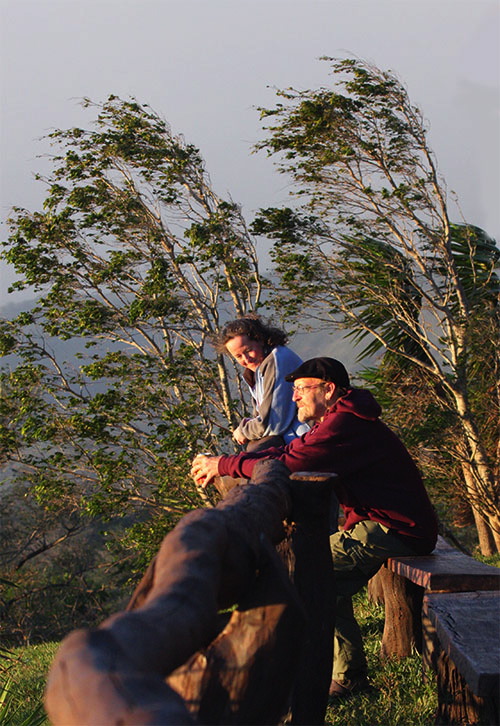
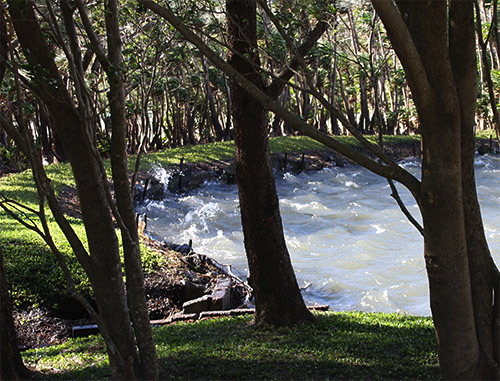
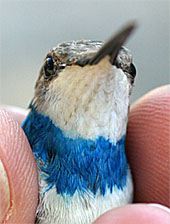 The tally included seven adult females, plus seven males--six "adults" and one partially gorgeted second-year bird. Other migratory Neotropical species we banded on 7 February were Yellow Warbler (2) and Tennessee Warbler (4).
The tally included seven adult females, plus seven males--six "adults" and one partially gorgeted second-year bird. Other migratory Neotropical species we banded on 7 February were Yellow Warbler (2) and Tennessee Warbler (4).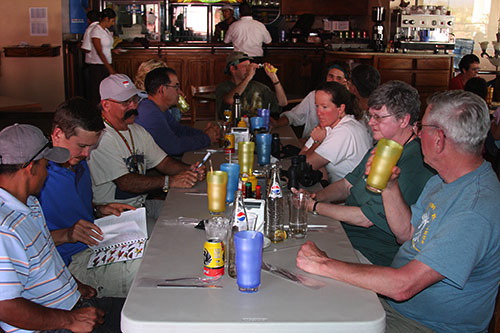


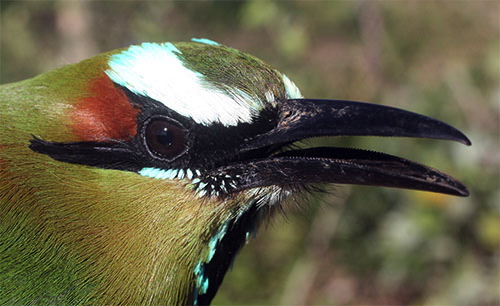
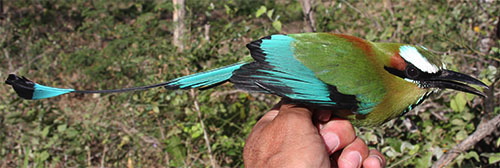
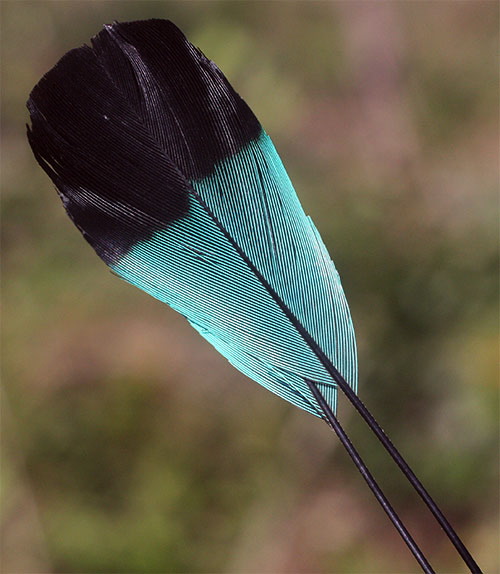
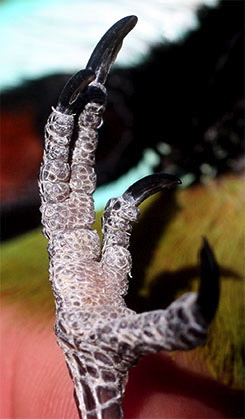 As the motmot preens or bumps against a substrate the weak barbs break off, leaving a bare section on the shaft. This unbarbed area is particularly long in the Turquoise-browed Motmot, less so in the Blue-crowned Motmot we also observed often in Guanacaste. Pendular tails apparently function in sexual selection (males with longer tails have greater pairing success) and in defense (tail wagging in a predator's presence tells that predator a wary motmot is already aware of its presence and is therefore less likely to be captured.
As the motmot preens or bumps against a substrate the weak barbs break off, leaving a bare section on the shaft. This unbarbed area is particularly long in the Turquoise-browed Motmot, less so in the Blue-crowned Motmot we also observed often in Guanacaste. Pendular tails apparently function in sexual selection (males with longer tails have greater pairing success) and in defense (tail wagging in a predator's presence tells that predator a wary motmot is already aware of its presence and is therefore less likely to be captured.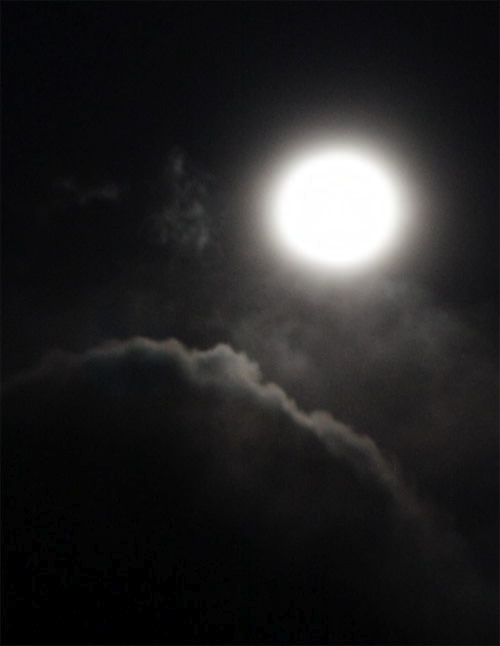
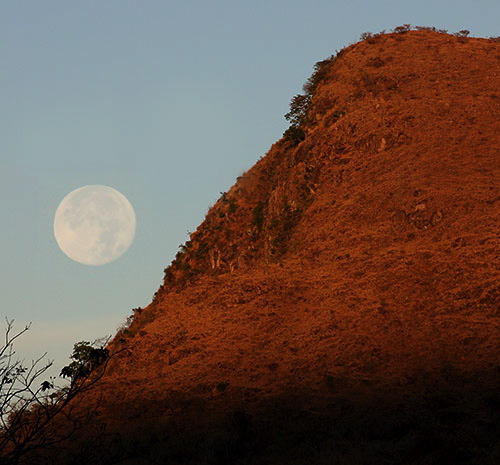
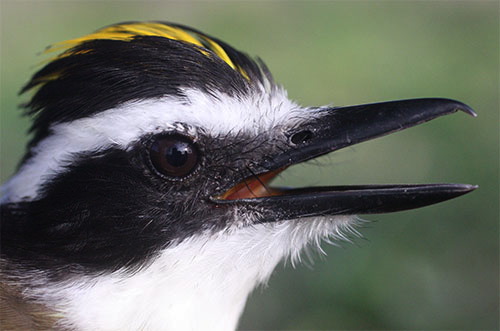
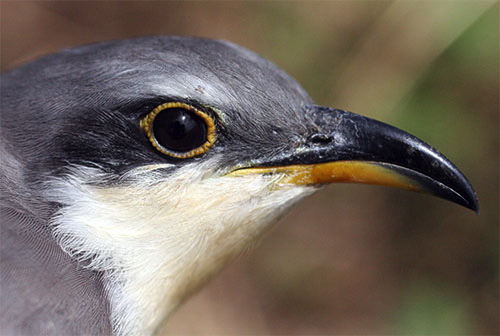

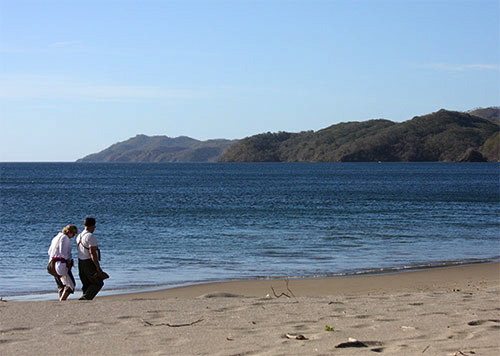
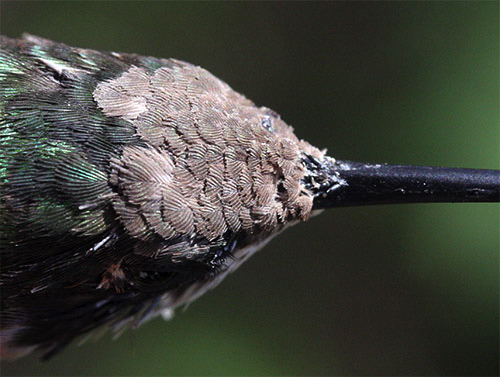
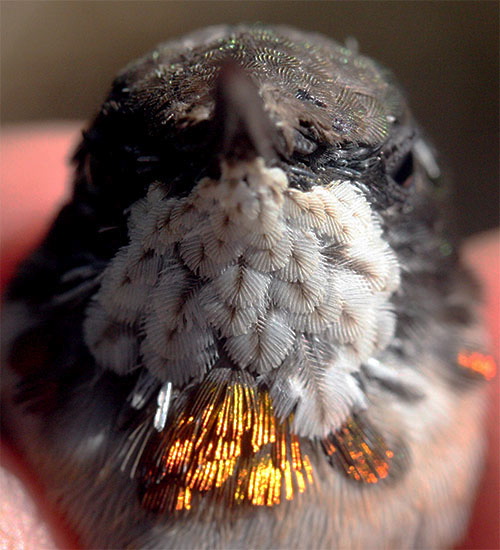
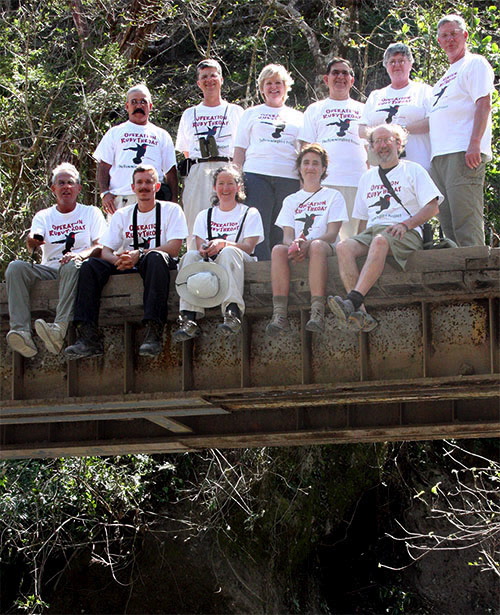
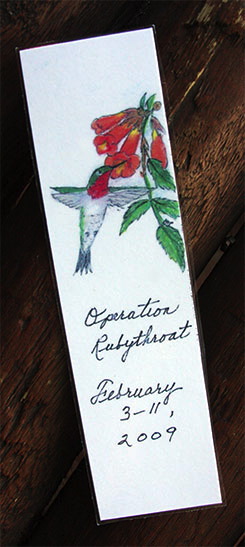 (The Beta Niners commemorative bookmark below right was designed by Pat Petersen.)
(The Beta Niners commemorative bookmark below right was designed by Pat Petersen.)